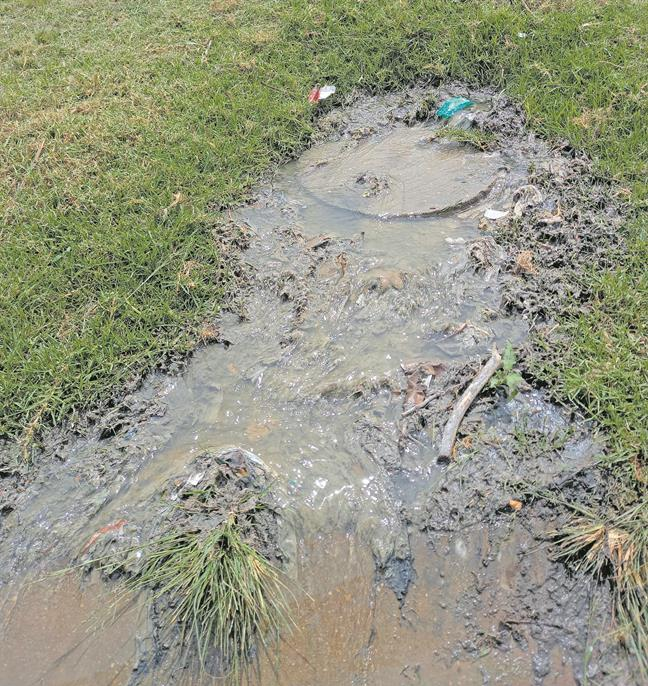KNYSNA NEWS - Water and Sanitation Deputy Minister Sello Seitlholo said the Knysna municipality had failed to enforce by-laws prohibiting the building of informal homes and structures on servitudes and on other sites, and this had contributed to the creation of the ongoing sewage crisis in the town and its surrounds - and the continued degradation of the Knysna Estuary.
Illegal connections
Seitlholo, after inspecting the town's wastewater treatment works and parts of its sewerage network on Thursday 23 January, was told by members of the municipality's leadership that the owners of informal homes had illegally linked facilities in their homes to sewer lines, which had led to the sporadic overflowing of nearby sewerage manholes.
The councillors had implied that they were unable to prevent informal home-owners from doing this.
In Bongani, Knysna, Seitlholo was shown an overflowing sewerage manhole - which one of the municipality's leaders linked to illegal connections - from where sewage ran into the Bongani river, which enters the estuary at the Ashmead channel.
'Unwillingness'
Seitlholo said while it was imperative that the municipality prevent illegal building to protect sewerage networks, he detected "an unwillingness" on the part of the leaders of the municipality to take action when sewage leaks were reported.
He said it appeared that the municipality did not have a budget to deal with sewage leaks and other problems with sewerage infrastructure.
 Deputy minister Sello Seitlholo, wearing a hat, after stopping at the Costa Sarda channel at the Knysna Estuary during his tour. Left is James McCarthy, head of the Garden Route District Municipality's health services in Knysna, and right is Sharon Sabbagh, the councillor for ward 9. The latest tests on water in the Costa Sarda channel indicate there is an E.coli count of 520 000 cfu/100ml in the water.
Deputy minister Sello Seitlholo, wearing a hat, after stopping at the Costa Sarda channel at the Knysna Estuary during his tour. Left is James McCarthy, head of the Garden Route District Municipality's health services in Knysna, and right is Sharon Sabbagh, the councillor for ward 9. The latest tests on water in the Costa Sarda channel indicate there is an E.coli count of 520 000 cfu/100ml in the water.
Treated water
At the Knysna wastewater treatment works, Seitlholo, accompanied by councillors, a media contingent, SANParks staff, Department of Water and Sanitation inspectors and health department officials on his inspection tour, was told that treated water from the plant with an E. coli count of 800 colony-forming units per 100 millilitres (cfu/100ml) was being released into the estuary via the Ashmead channel.
Sharon Sabbagh, the councillor for ward 9, said "for recreation purposes the count has to be 500 (cfu/100ml) or below".
 An overflowing sewerage manhole in Bongani, Knysna, which was pointed out to Deputy Minister Seitlholo.
An overflowing sewerage manhole in Bongani, Knysna, which was pointed out to Deputy Minister Seitlholo.
'Can I speak to you alone?'
While the party took a lunch break, the deputy minister, after saying, "can I just speak to you alone? because there's something that I just need to get off my chest", met privately with mayor Aubrey Tsengwa, deputy mayor Alberto Marbi, and councillor Beauty Charlie, the MMC for infrastructure.
After lunch the inspection tour continued, and the party, sans the municipality leaders, eventually arrived at the Costa Sarda channel, where water also enters the estuary.
E.coli count of 520 000
The latest tests on water in the Costa Sarda channel, undertaken by an independent laboratory on 16 January, indicated there was an E.coli count of 520 000 cfu/100ml in the water.
An overpowering stench emanated from the site, as at numerous other sites visited.
Tests on water from a culvert in Queen Street, Knysna, indicated there was an E.coli count of 810 000 in the water there.
Expressed despair
At the Costa Sarda channel, Seitlholo expressed despair at the magnitude of the dysfunction he had witnessed, and at information on sections of the sewerage network and sewage spills he had been given.
He said if Knysna business owners formed a group aimed at dealing with the crisis, he would return and offer them his support.
"Let's come together and see if there's service level agreements that can be entered into, to remedy the situation."
‘We bring you the latest Garden Route, Hessequa, Karoo news’
















